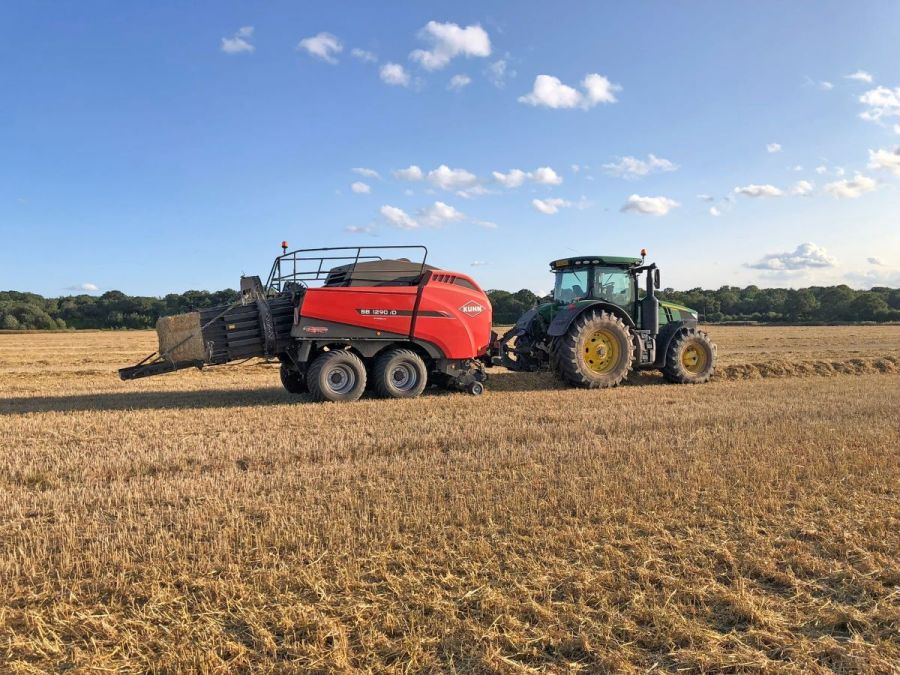The requirement for high-density top-quality bales has seen one farming business adopt two new large square balers. CPM discovers not only the difference these have made but also the savings.
“The capacity of the balers really helps get top quality straw in the short windows we’ve experienced.” CHARLIE STEER
By Melanie Jenkins
With aims to reduce the business’ carbon footprint while trying to maintain high output from livestock, Grosvenor Farms on the Eaton Estate, Cheshire, is adopting new technology to optimise its straw bale production.
Growing 1000ha of cereals including winter wheat, winter barley and spring barley, and 1100ha of maize and grass for forage, for the farm’s 2500 cows, which produce 34M litres of milk for Tesco, the business requires reliable high throughput balers.
Having worked with Kuhn equipment in the past including boom and disc fertiliser spreaders, mowers, tedders and power harrows, switching to Kuhn balers was something arable manager Charlie Steer, had confidence in.
After purchasing an SB 1290 iD for the farm in 2023, he added a second to the fleet in 2024. “We were slow on the uptake of high-density balers but it’s the best feature because of the efficiency increase,” he explains. “We’re now carting fewer loads back to the stores and it means we can fit more bales in the shed while avoiding the cost of having to build new storage.”
Operator Dan James has also been impressed with the balers so far, finding them simple and straightforward to use, connecting seamlessly to the farm’s tractors via ISOBUS. He also likes that if there’s a lump while he’s baling haylage, he can drop the floor and start again without issue.
One of the balers has the optional crop cutter which is useful when producing haylage. “The baler can chop to avoid this at feeding, however, we’re going to try it with straw this year so that it goes through the mixer easier,” says Dan. “It’s easy to use via the ISOBUS and it’s possible to drop the knives out if you don’t want to use them.”
Charlie appreciates the flexibility of running the balers on lower horsepower tractors such as the farm’s 7310R, 6R 250s, 6215 or 6195 John Deeres. “We spend a lot of time and resources trying to reduce the carbon footprint of what we produce, so fuel is a key emissions point.”
The TwinPact double plunger has been useful when the balers are functioning at speed, taking a lot of the plunger rock out of the baler and tractor compared with the previous large square balers that Charlie has used.
Dan agrees, noting that the tractors aren’t rocked as much. “It’s smoother now and because of the twin axels, it’s better when we’re travelling across ruts.”
Charlie also likes the moisture metre which helps the farm maintain high-quality straw for its dairies. “We hammer mill a portion of the straw which is included in the TMR for the cows but the rest is used for bedding which means we require good quality straw at the right moisture which isn’t always easy in wetter years,” he says.
“The capacity of the balers helps achieve top quality straw in the short windows we’ve experienced in recent years and getting an even square sided 500kg bale is the target for all crops.
“Quality of the straw is a significant factor, which comes down to timeliness and good, conscientious operators, who consistently monitor bale moisture and weights, which we’re lucky to have on the team.”
Because of the requirement to maintain this high-quality, Dan agrees that the moisture metre is useful, but due to the requirement to produce high quality bedding, they also use probe metres as well. “At night when the dew condenses it gets into the baler which can result in discrepancies with the moisture metre because it’s on the outside of the baler, so double checking with the probe is about reassurance.”
When first using the crop cutter baler for haylage, while moving between fields, it produced a few off-shaped bales. However, as soon as Dan moved to larger areas, bale confirmation became uniform and he hasn’t experienced this since.
Overall he’s noticed that the balers produce a better confirmation that are squarer and are the same length and shape. “When ran the previous balers we’d find variation with some longer and others shorter but they’re now very consistent.”
Looking at the return on investment, Charlie points out that the business tends to run kit for a long time, with the SB 1290 iDs replacing 20- and 12-year-old New Hollands. “But based on the jump in productivity in now producing high-density bales, plus more tonnes carted with fewer journeys, quality improvements and a lower requirement for outdoor stacks, we’re assuming a 4.2-year payback.
“We find that in both carbon and cost reduction per measure of output, be that a tonne of grain or a litre of milk, yield is still king. Having quality straw or hay to include in rations or to bed youngstock might seem like a small point, but lots of small points add up to bigger ones,” concludes Charlie.
This article was taken from the latest issue of CPM. Read the article in full here.
For more articles like this, subscribe here.
Sign up for Crop Production Magazine’s FREE e-newsletter here.




